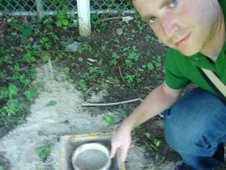

By Matthew Lysiak
The Brooklyn Paper
Seven weeks after the once-in-a-lifetime tornado touched down in Bay Ridge, life for the handful of households in the tornado’s angry path has not returned to normal.
Ida Thomas didn’t need to wait for President Bush to declare her Narrows Avenue block a disaster area — all she had to do was look at her property.
“I’ve had to borrow money from friends and family to fix what I could,” said Thomas, whose damages have exceeded $10,000. “Life has been quite difficult and I have had to live with the workers.”
The storm damaged her garage, floors, and even the structural integrity of her home’s foundation. Most important, she only had enough money to partially fix the roof — so life has meant praying for dry weather.
“Every time it rains, my roof takes more damage,” said Thomas. “God forbid, I don’t get it fixed before it snows. I’m not sure the roof will hold.”
Thomas has been working with Federal Emergency Management Agency, which has only offered loans and not the grants for which she hoped she would be eligible.
“I could really use those grants,” added Thomas. FEMA told Thomas that she must apply for the loans first before she can look into the grants.
After the twister touched down on 72nd Street and Narrows Avenue, it bounced up and then landed again around 67th Street between Fourth and Seventh avenues.
On those blocks, buildings are still covered with big blue tarps, and bright yellow signs posted by the Department of Buildings are taped to many doors warning of the structural damage within.
That’s also where Ho Wong lives, amongst constant construction, dust, and tools at his 69th Street home. Seven weeks after the winds blew through his world, Wong still lives with constant construction on his roof and debris in his yard.
Wong said his landlord is handling the work, and the noise keeps him up at night.
“It should be like this for a few more weeks,” said Wong. “Some nights it is pretty hard to sleep.”
The doorways on the tornados path are also crammed with business cards from opportunistic construction companies looking to cash on in on the new demand for labor.
Helen McCormack, who lives at 102 72nd St., lost a tree in her backyard. An arborist estimated that it would cost more than $1,000 remove the damage and make her yard usable again.
“Now when my grandkids come over they have to stay inside,” said McCormack. “It is a real problem.”
She didn’t think the case was something that would make her eligible for aid — which is one of the problems, at least according to FEMA spokeswoman Barbara Lynch.
“If the tree poses a danger, she should definitely apply,” said Lynch.
“One of the surprising problems we are having now is that so many people who have damage aren’t applying.”


